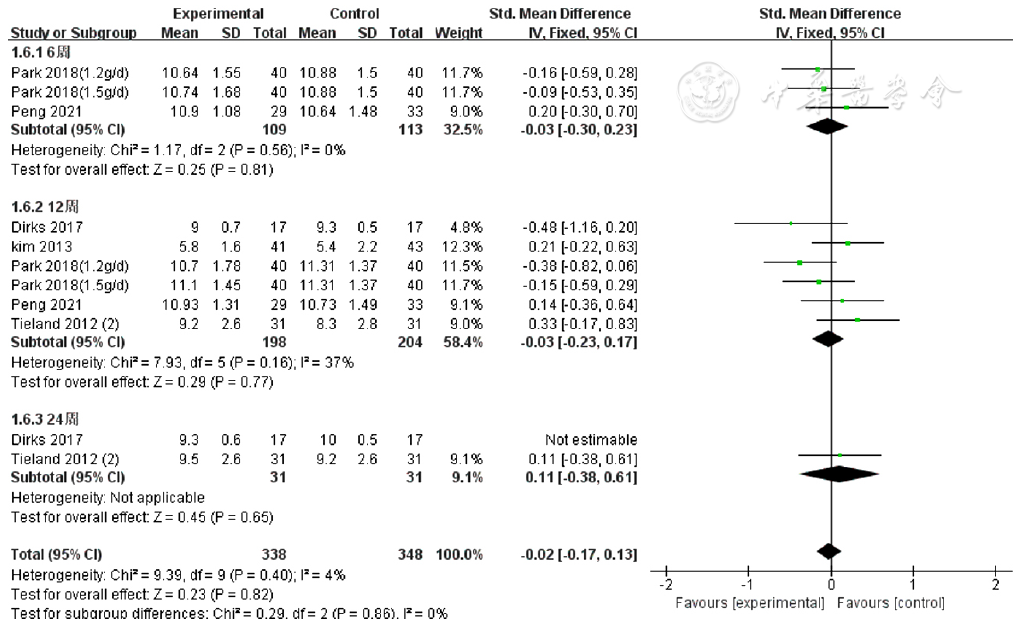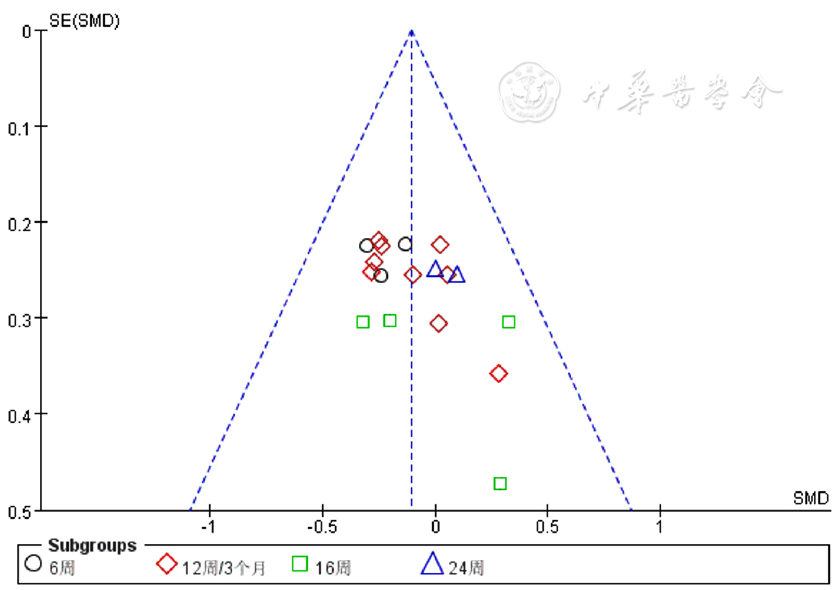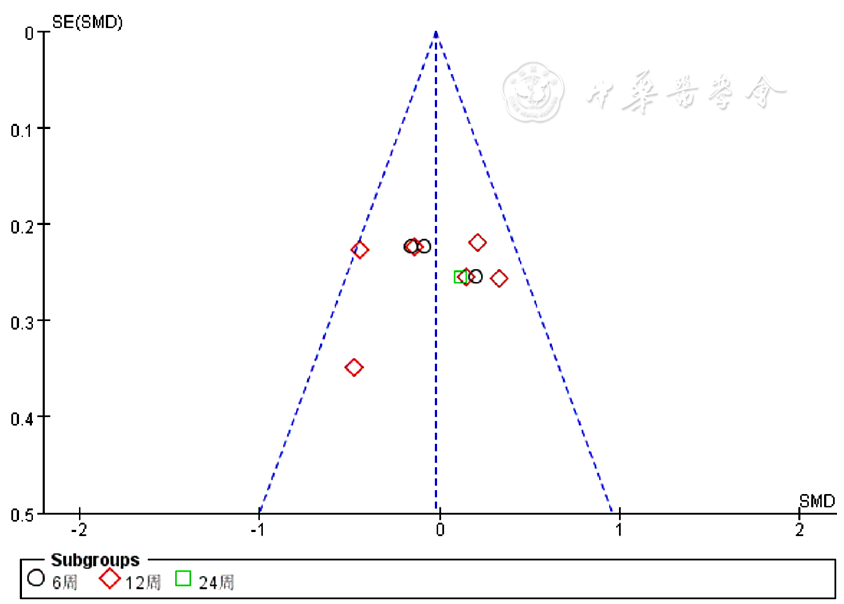中国全科医学 ›› 2023, Vol. 26 ›› Issue (23): 2854-2863.DOI: 10.12114/j.issn.1007-9572.2022.0699
所属专题: 老年人群健康最新文章合辑; 衰弱最新文章合辑; 胰腺炎最新文章合辑; 全科质控专项研究; 老年问题最新文章合辑
收稿日期:2022-09-11
修回日期:2022-12-02
出版日期:2023-08-15
发布日期:2023-02-23
通讯作者:
许勤
基金资助:
GUO Yinning, MIAO Xueyi, JIANG Xiaoman, XU Ting, XU Qin*( )
)
Received:2022-09-11
Revised:2022-12-02
Published:2023-08-15
Online:2023-02-23
Contact:
XU Qin
摘要: 背景 衰弱会增加老年人健康相关负面结果的风险,蛋白质补充可能是一个有效改善衰弱的途径,但目前关于蛋白质补充对衰弱的影响尚有分歧。 目的 系统评价蛋白质补充对衰弱/衰弱前期老年人肌肉质量、肌肉力量和身体功能的影响。 方法 全面系统检索中国知网、万方数据知识服务平台、维普网、PubMed、Web of Science、Embase、Cochrane Library、CINAHL、Medline各数据库建库至2022年6月发表的蛋白质补充对衰弱/衰弱前期老年人肌肉质量、肌肉力量和身体功能等方面影响的随机对照试验。筛选文献,对符合纳排标准的文献进行质量评价、数据提取,并采用RevMan 5.4进行Meta分析,以探讨蛋白质补充对衰弱/衰弱前期老年人肌肉质量、肌肉力量和身体功能等方面的影响。且对于肌肉力量(握力)这一结局指标,因报道文献较多,本研究还根据蛋白质补充量(<30 g/d亚组和≥30 g/d亚组)、衰弱状态(衰弱前期亚组、衰弱期亚组、衰弱及衰弱前期亚组)、衰弱评估工具〔衰弱表型评估工具(FP)亚组和非FP亚组〕、人群(亚洲人亚组和欧洲人亚组)、平均年龄(70~<75岁亚组、75~<80岁亚组和80~<85岁亚组)进行亚组分析,以进一步探讨不同亚组的蛋白质补充对握力的影响。 结果 最终纳入12篇文献(2篇文献为衰弱前期,3篇文献为衰弱,7篇文献为衰弱及衰弱前期),共833例衰弱/衰弱前期老年人,其中蛋白补充组422例、对照组411例。Meta分析结果显示,蛋白质补充可以提高衰弱/衰弱前期老年人步行速度〔MD=0.03,95%CI(0,0.06),P=0.05〕,但在改善衰弱/衰弱前期老年人肌肉质量(四肢瘦体质量)、肌肉力量(握力)、其他身体功能(平衡能力、站立行走试验、简易体能状况量表评分)和衰弱评分方面,差异无统计学意义(P>0.05);人群亚组分析显示,亚洲人亚组的蛋白质补充对握力的影响与欧洲人亚组相比,差异有统计学意义(χ2=5.76,P=0.02)。 结论 蛋白质补充可以提高衰弱老年人的步行速度,但在改善其肌肉质量、力量和其他身体功能方面未显示明显优势。建议进一步开展更长补充时长、不同蛋白质类型、不同补充量、不同地区人群对不同衰弱状态老年人影响的研究,以期寻找最佳的蛋白质补充模式,为衰弱管理提供更充分的循证依据。
| 作者 | 发表时间(年) | 国家 | 研究类型 | 衰弱评估 | 纳入人群 | 样本量(T/C) | 年龄(M±SD,岁) | 干预措施 | 测量时间 | 结局指标 | ||
|---|---|---|---|---|---|---|---|---|---|---|---|---|
| T | C | T | C | |||||||||
| DIRKS等[ | 2017 | 荷兰 | 2臂随机对照试验 | FP | 衰弱及衰弱前期老年人 | 34(17/17) | 76.00±2.00 | 77.00±2.00 | 250 mL蛋白质饮料 | 安慰剂 | 基线、12周、24周 | ①②⑥ |
| KANG等[ | 2019 | 中国 | 2臂随机对照试验 | FP | 衰弱及衰弱前期老年人 | 115(66/49) | 76.79±7.11 | 78.04±6.82 | 乳清蛋白补充剂 | 空白对照 | 基线、4周、8周、12周 | ②③④⑥ |
| ROSCHEL等[ | 2021 | 巴西 | 4个亚研究的随机对照试验 | FP | 衰弱及衰弱前期老年人 | 亚组1:44(22/22) | 72.00±6.00 | 亮氨酸补充剂 | 安慰剂 | 基线、16周 | ①②⑤ | |
| 亚组2:44(22/22) | 乳清蛋白补充剂 | 安慰剂 | ||||||||||
| 亚组3:44(22/22) | 大豆植物蛋白补充剂 | 安慰剂 | ||||||||||
| PENG等[ | 2021 | 中国 | 2臂随机对照试验 | FP | 衰弱前期老年人 | 62(29/33) | 70.66±4.16 | 71.48±3.46 | 含HP HMB的口服营养补充剂 | 空白对照 | 基线、6周、12周 | ②③④⑥ |
| TIELAND等[ | 2012 | 荷兰 | 2臂随机对照试验 | FP | 衰弱及衰弱前期老年人 | 62(31/31) | 78.00±9.00 | 79.00±6.00 | 250 mL蛋白饮料 | 安慰剂 | 基线、12周、24周 | ①②⑥ |
| TIELAND等[ | 2012 | 荷兰 | 2臂随机对照试验 | FP | 衰弱及衰弱前期老年人 | 65(34/31) | 78.00±1.00 | 81.00±1.00 | 250 mL蛋白饮料 | 安慰剂 | 基线、12周、24周 | ①②③ |
| PARK等[ | 2018 | 韩国 | 3臂随机对照试验 | CHS | 衰弱老年人 | 80(40/40) | 77.30±3.67 | 76.83±3.86 | 1.2 g·kg-1·d-1的蛋白粉 | 安慰剂 | 基线、6周、12周 | ②③④ ⑤⑥⑦ |
| 80(40/40) | 76.80±3.70 | 76.83±3.86 | 1.5 g·kg-1·d-1的蛋白粉 | |||||||||
| KIM等[ | 2015 | 日本 | 4臂随机对照试验 | FP | 衰弱老年女性 | 64(32/32) | 81.00±2.80 | 80.30±3.30 | 乳脂球丸补充 | 安慰剂 | 基线、3个月 | ②⑤ |
| KIM等[ | 2013 | 韩国 | 2臂随机对照试验 | FWG | 衰弱老年人 | 87(43/44) | 78.90±5.50 | 78.40±6.00 | 200 mL配方奶粉 | 空白对照 | 基线、12周 | ②③⑤⑥ |
| CALDO-SILVA等(1)(2)[ | 2021 | 葡萄牙 | 多阶段4臂随机对照试验 | FP | 衰弱及衰弱前期老年人 | 20(7/13) | 84.20±5.80 | 83.10±5.40 | 支链氨基酸补充 | 空白对照 | 基线、16周 | ②⑦ |
| BIESEK等[ | 2021 | 瑞士 | 5臂随机对照试验 | FP | 衰弱前期老年女性 | 32(17/15) | 73.10±5.30 | 70.40±3.90 | 200 mL蛋白补充剂(内含21 g乳清分离蛋白、2 300 mg亮氨酸和12 g必需氨基酸) | 空白对照 | 基线、12周 | ② |
表1 纳入文献的基本特征
Table 1 Basic characteristics of included RCTs
| 作者 | 发表时间(年) | 国家 | 研究类型 | 衰弱评估 | 纳入人群 | 样本量(T/C) | 年龄(M±SD,岁) | 干预措施 | 测量时间 | 结局指标 | ||
|---|---|---|---|---|---|---|---|---|---|---|---|---|
| T | C | T | C | |||||||||
| DIRKS等[ | 2017 | 荷兰 | 2臂随机对照试验 | FP | 衰弱及衰弱前期老年人 | 34(17/17) | 76.00±2.00 | 77.00±2.00 | 250 mL蛋白质饮料 | 安慰剂 | 基线、12周、24周 | ①②⑥ |
| KANG等[ | 2019 | 中国 | 2臂随机对照试验 | FP | 衰弱及衰弱前期老年人 | 115(66/49) | 76.79±7.11 | 78.04±6.82 | 乳清蛋白补充剂 | 空白对照 | 基线、4周、8周、12周 | ②③④⑥ |
| ROSCHEL等[ | 2021 | 巴西 | 4个亚研究的随机对照试验 | FP | 衰弱及衰弱前期老年人 | 亚组1:44(22/22) | 72.00±6.00 | 亮氨酸补充剂 | 安慰剂 | 基线、16周 | ①②⑤ | |
| 亚组2:44(22/22) | 乳清蛋白补充剂 | 安慰剂 | ||||||||||
| 亚组3:44(22/22) | 大豆植物蛋白补充剂 | 安慰剂 | ||||||||||
| PENG等[ | 2021 | 中国 | 2臂随机对照试验 | FP | 衰弱前期老年人 | 62(29/33) | 70.66±4.16 | 71.48±3.46 | 含HP HMB的口服营养补充剂 | 空白对照 | 基线、6周、12周 | ②③④⑥ |
| TIELAND等[ | 2012 | 荷兰 | 2臂随机对照试验 | FP | 衰弱及衰弱前期老年人 | 62(31/31) | 78.00±9.00 | 79.00±6.00 | 250 mL蛋白饮料 | 安慰剂 | 基线、12周、24周 | ①②⑥ |
| TIELAND等[ | 2012 | 荷兰 | 2臂随机对照试验 | FP | 衰弱及衰弱前期老年人 | 65(34/31) | 78.00±1.00 | 81.00±1.00 | 250 mL蛋白饮料 | 安慰剂 | 基线、12周、24周 | ①②③ |
| PARK等[ | 2018 | 韩国 | 3臂随机对照试验 | CHS | 衰弱老年人 | 80(40/40) | 77.30±3.67 | 76.83±3.86 | 1.2 g·kg-1·d-1的蛋白粉 | 安慰剂 | 基线、6周、12周 | ②③④ ⑤⑥⑦ |
| 80(40/40) | 76.80±3.70 | 76.83±3.86 | 1.5 g·kg-1·d-1的蛋白粉 | |||||||||
| KIM等[ | 2015 | 日本 | 4臂随机对照试验 | FP | 衰弱老年女性 | 64(32/32) | 81.00±2.80 | 80.30±3.30 | 乳脂球丸补充 | 安慰剂 | 基线、3个月 | ②⑤ |
| KIM等[ | 2013 | 韩国 | 2臂随机对照试验 | FWG | 衰弱老年人 | 87(43/44) | 78.90±5.50 | 78.40±6.00 | 200 mL配方奶粉 | 空白对照 | 基线、12周 | ②③⑤⑥ |
| CALDO-SILVA等(1)(2)[ | 2021 | 葡萄牙 | 多阶段4臂随机对照试验 | FP | 衰弱及衰弱前期老年人 | 20(7/13) | 84.20±5.80 | 83.10±5.40 | 支链氨基酸补充 | 空白对照 | 基线、16周 | ②⑦ |
| BIESEK等[ | 2021 | 瑞士 | 5臂随机对照试验 | FP | 衰弱前期老年女性 | 32(17/15) | 73.10±5.30 | 70.40±3.90 | 200 mL蛋白补充剂(内含21 g乳清分离蛋白、2 300 mg亮氨酸和12 g必需氨基酸) | 空白对照 | 基线、12周 | ② |
| 纳入研究 | 随机序列的产生 | 分配隐藏 | 盲法 | 结局数据完整性 | 选择性结果报告 | 其他来源偏倚 | 质量等级(级) | |
|---|---|---|---|---|---|---|---|---|
| 研究对象实施盲法 | 评价者实施盲法 | |||||||
| DIRKS等[ | 低风险偏倚 | 不清楚 | 低风险偏倚 | 低风险偏倚 | 低风险偏倚 | 低风险偏倚 | 低风险偏倚 | B |
| KANG等[ | 不清楚 | 不清楚 | 低风险偏倚 | 不清楚 | 低风险偏倚 | 低风险偏倚 | 不清楚 | B |
| ROSCHEL等[ | 低风险偏倚 | 不清楚 | 低风险偏倚 | 低风险偏倚 | 低风险偏倚 | 低风险偏倚 | 低风险偏倚 | B |
| PENG等[ | 低风险偏倚 | 低风险偏倚 | 不清楚 | 不清楚 | 低风险偏倚 | 低风险偏倚 | 不清楚 | B |
| TIELAND等[ | 低风险偏倚 | 不清楚 | 低风险偏倚 | 低风险偏倚 | 低风险偏倚 | 低风险偏倚 | 低风险偏倚 | B |
| TIELAND等[ | 低风险偏倚 | 不清楚 | 低风险偏倚 | 低风险偏倚 | 低风险偏倚 | 低风险偏倚 | 低风险偏倚 | B |
| PARK等[ | 低风险偏倚 | 低风险偏倚 | 低风险偏倚 | 低风险偏倚 | 低风险偏倚 | 低风险偏倚 | 低风险偏倚 | A |
| KIM等[ | 低风险偏倚 | 低风险偏倚 | 低风险偏倚 | 低风险偏倚 | 低风险偏倚 | 低风险偏倚 | 低风险偏倚 | A |
| KIM等[ | 低风险偏倚 | 低风险偏倚 | 低风险偏倚 | 低风险偏倚 | 低风险偏倚 | 低风险偏倚 | 低风险偏倚 | A |
| CALDO-SILVA等[ | 低风险偏倚 | 不清楚 | 低风险偏倚 | 不清楚 | 低风险偏倚 | 低风险偏倚 | 不清楚 | B |
| CALDO-SILVA等[ | 低风险偏倚 | 不清楚 | 低风险偏倚 | 不清楚 | 低风险偏倚 | 低风险偏倚 | 不清楚 | B |
| BIESEK等[ | 低风险偏倚 | 不清楚 | 低风险偏倚 | 不清楚 | 低风险偏倚 | 低风险偏倚 | 不清楚 | B |
表2 纳入文献方法学质量评价结果
Table 2 Methodological quality assessment results of included studies
| 纳入研究 | 随机序列的产生 | 分配隐藏 | 盲法 | 结局数据完整性 | 选择性结果报告 | 其他来源偏倚 | 质量等级(级) | |
|---|---|---|---|---|---|---|---|---|
| 研究对象实施盲法 | 评价者实施盲法 | |||||||
| DIRKS等[ | 低风险偏倚 | 不清楚 | 低风险偏倚 | 低风险偏倚 | 低风险偏倚 | 低风险偏倚 | 低风险偏倚 | B |
| KANG等[ | 不清楚 | 不清楚 | 低风险偏倚 | 不清楚 | 低风险偏倚 | 低风险偏倚 | 不清楚 | B |
| ROSCHEL等[ | 低风险偏倚 | 不清楚 | 低风险偏倚 | 低风险偏倚 | 低风险偏倚 | 低风险偏倚 | 低风险偏倚 | B |
| PENG等[ | 低风险偏倚 | 低风险偏倚 | 不清楚 | 不清楚 | 低风险偏倚 | 低风险偏倚 | 不清楚 | B |
| TIELAND等[ | 低风险偏倚 | 不清楚 | 低风险偏倚 | 低风险偏倚 | 低风险偏倚 | 低风险偏倚 | 低风险偏倚 | B |
| TIELAND等[ | 低风险偏倚 | 不清楚 | 低风险偏倚 | 低风险偏倚 | 低风险偏倚 | 低风险偏倚 | 低风险偏倚 | B |
| PARK等[ | 低风险偏倚 | 低风险偏倚 | 低风险偏倚 | 低风险偏倚 | 低风险偏倚 | 低风险偏倚 | 低风险偏倚 | A |
| KIM等[ | 低风险偏倚 | 低风险偏倚 | 低风险偏倚 | 低风险偏倚 | 低风险偏倚 | 低风险偏倚 | 低风险偏倚 | A |
| KIM等[ | 低风险偏倚 | 低风险偏倚 | 低风险偏倚 | 低风险偏倚 | 低风险偏倚 | 低风险偏倚 | 低风险偏倚 | A |
| CALDO-SILVA等[ | 低风险偏倚 | 不清楚 | 低风险偏倚 | 不清楚 | 低风险偏倚 | 低风险偏倚 | 不清楚 | B |
| CALDO-SILVA等[ | 低风险偏倚 | 不清楚 | 低风险偏倚 | 不清楚 | 低风险偏倚 | 低风险偏倚 | 不清楚 | B |
| BIESEK等[ | 低风险偏倚 | 不清楚 | 低风险偏倚 | 不清楚 | 低风险偏倚 | 低风险偏倚 | 不清楚 | B |
| 亚组 | 类别 | 纳入研究数(篇) | 效应量 | 异质性检验 | |||
|---|---|---|---|---|---|---|---|
| SMD | 95%CI | P值 | I2(%) | P值 | |||
| 蛋白质补充量 | <30 g/d | 3 | -0.11 | (-0.40,0.19) | 0.48 | 0 | 0.44 |
| ≥30 g/d | 5 | 0.01 | (-0.22,0.24) | 0.92 | 32 | 0.19 | |
| 衰弱状态 | 衰弱前期 | 2 | 0.03 | (-0.38,0.43) | 0.90 | 0 | 0.38 |
| 衰弱期 | 3 | -0.19 | (-0.41,0.04) | 0.10 | 0 | 0.77 | |
| 衰弱及衰弱前期 | 6 | 0.03 | (-0.17,0.22) | 0.79 | 25 | 0.22 | |
| 衰弱评估工具 | FP | 9 | -0.01 | (-0.17,0.16) | 0.93 | 14 | 0.31 |
| 非FP | 2 | -0.16 | (-0.41,0.09) | 0.21 | 0 | 0.63 | |
| 人群 | 亚洲人 | 5 | -0.17 | (-0.35,0.01) | 0.06 | 0 | 0.94 |
| 欧洲人 | 5 | 0.23 | (-0.04,0.50) | 0.10 | 13 | 0.33 | |
| 平均年龄 | 70~<75岁 | 3 | -0.13 | (-0.39,0.13) | 0.32 | 0 | 0.76 |
| 75~<80岁 | 5 | -0.05 | (-0.24,0.13) | 0.58 | 39 | 0.13 | |
| 80~<85岁 | 2 | -0.16 | (-0.59,0.28) | 0.49 | 11 | 0.29 | |
表3 蛋白质补充对握力影响的亚组分析
Table 3 Subgroup analysis of the effects of protein supplementation on grip strength
| 亚组 | 类别 | 纳入研究数(篇) | 效应量 | 异质性检验 | |||
|---|---|---|---|---|---|---|---|
| SMD | 95%CI | P值 | I2(%) | P值 | |||
| 蛋白质补充量 | <30 g/d | 3 | -0.11 | (-0.40,0.19) | 0.48 | 0 | 0.44 |
| ≥30 g/d | 5 | 0.01 | (-0.22,0.24) | 0.92 | 32 | 0.19 | |
| 衰弱状态 | 衰弱前期 | 2 | 0.03 | (-0.38,0.43) | 0.90 | 0 | 0.38 |
| 衰弱期 | 3 | -0.19 | (-0.41,0.04) | 0.10 | 0 | 0.77 | |
| 衰弱及衰弱前期 | 6 | 0.03 | (-0.17,0.22) | 0.79 | 25 | 0.22 | |
| 衰弱评估工具 | FP | 9 | -0.01 | (-0.17,0.16) | 0.93 | 14 | 0.31 |
| 非FP | 2 | -0.16 | (-0.41,0.09) | 0.21 | 0 | 0.63 | |
| 人群 | 亚洲人 | 5 | -0.17 | (-0.35,0.01) | 0.06 | 0 | 0.94 |
| 欧洲人 | 5 | 0.23 | (-0.04,0.50) | 0.10 | 13 | 0.33 | |
| 平均年龄 | 70~<75岁 | 3 | -0.13 | (-0.39,0.13) | 0.32 | 0 | 0.76 |
| 75~<80岁 | 5 | -0.05 | (-0.24,0.13) | 0.58 | 39 | 0.13 | |
| 80~<85岁 | 2 | -0.16 | (-0.59,0.28) | 0.49 | 11 | 0.29 | |

图7 蛋白质补充对SPPB评分的影响
Figure 7 Forest plot of the effect of protein supplementation on the Short Physical Performance Battery score in frail older adults

图9 蛋白质补充对握力影响研究的发表偏倚风险
Figure 9 Funnel plot of risk of publication bias for the effect of protein supplementation on grip strength in frail older adults

图10 蛋白质补充对SPPB评分影响研究的发表偏倚风险
Figure 10 Funnel plot of risk of publication bias for the effect of protein supplementation on the Short Physical Performance Battery score in frail older adults
| [1] |
新华社. 中共中央国务院印发《"健康中国2030"规划纲要》[EB/OL].(2016-10-25)[2022-07-12].
|
| [2] |
国家统计局. 第七次全国人口普查公报(第五号)[EB/OL].(2021-05-11)[2022-07-10].
|
| [3] |
|
| [4] |
|
| [5] |
|
| [6] |
马丽娜,陈彪. 老年人衰弱综合征的研究现状及发展趋势[J]. 中华老年医学杂志,2020,39(4):369-372. DOI:10.3760/cma.j.issn.0254-9026.2020.04.001.
|
| [7] |
|
| [8] |
|
| [9] |
|
| [10] |
|
| [11] |
|
| [12] |
|
| [13] |
|
| [14] |
|
| [15] | |
| [16] |
|
| [17] |
|
| [18] |
|
| [19] |
|
| [20] |
|
| [21] |
|
| [22] |
|
| [23] |
|
| [24] |
|
| [25] |
|
| [26] |
|
| [27] |
杨玲,杜娟,刘荣雁,等. 肌肉减少症病因学研究现状与展望[J]. 中国骨质疏松杂志,2020,26(11):1689-1693.
|
| [28] |
|
| [29] |
|
| [30] |
|
| [31] |
|
| [32] |
|
| [33] |
|
| [34] |
|
| [35] |
|
| [36] |
赵杰. 山东省70kg级男子健美运动员业余组赛前腿部训练的实践研究[D]. 济南:山东体育学院,2020.
|
| [37] |
|
| [38] |
|
| [39] |
|
| [40] |
|
| [1] | 许佳兰, 阎红, 文君, 周紫彤, 王思宇. 老年癌症患者潜在不适当用药发生率的Meta分析[J]. 中国全科医学, 2025, 28(30): 3815-3822. |
| [2] | 李玲, 李雅萍, 钱时兴, 聂婧, 陆春华, 李霞. 社区中老年人认知功能影响因素及风险预测研究[J]. 中国全科医学, 2025, 28(30): 3773-3778. |
| [3] | 张红石, 曲子涵, 孙雪峰, 王宇峰, 丛德毓, 张野. 基于蛋白质组学技术分析腹部推拿对失眠大鼠下丘脑的影响研究[J]. 中国全科医学, 2025, 28(27): 3399-3409. |
| [4] | 周鹏龙, 苌静, 丁素英, 陈静锋, 王涛, 李晨阳. 脂肪-肌肉比的年龄分层差异与高尿酸血症的相关性研究[J]. 中国全科医学, 2025, 28(27): 3375-3384. |
| [5] | 张天宇, 于海搏, 陈飞, 李新, 张佳佳, 詹晓凯, 申曼, 汤然, 范斯斌, 赵凤仪, 黄仲夏. POEMS综合征全身系统性治疗疗效和安全性的Meta分析[J]. 中国全科医学, 2025, 28(27): 3447-3455. |
| [6] | 全家霖, 朱琳, 苏煜, 陈泽恺, 陈梓淇, 张卓凡. 运动方式对超重或肥胖儿童青少年执行功能改善效果的网状Meta分析[J]. 中国全科医学, 2025, 28(27): 3422-3431. |
| [7] | 程雨欣, 方嘉敏, 梁好, 汪志玲, 魏琳, 廖惠莲, 徐明明, 陈玉梅, 李燕芬, 董丽娟, 郭银桂. 老年择期手术患者术前血小板计数/白蛋白比值与术后新发衰弱的相关性分析:一项多中心研究[J]. 中国全科医学, 2025, 28(27): 3359-3367. |
| [8] | 胡洁蔓, 谭斐翔, 袁安新, 陈世宇, 唐楚蕾, 殷月姮, 巴磊, 许勤. 结直肠癌患者术后衰弱变化轨迹及影响因素研究[J]. 中国全科医学, 2025, 28(26): 3276-3282. |
| [9] | 崔宇阳, 程桂荣, 曾燕, 黄招兰, 谭伟. 社区老年人婚姻状况和社会支持及生活习惯与认知障碍的关联:基于湖北老年记忆队列基线调查[J]. 中国全科医学, 2025, 28(26): 3240-3247. |
| [10] | 燕芳红, 彭国恬, 张国莉, 孙瑞仪, 马玉霞, 韩琳. 医联体内老年慢性病管理内容的匹配分析:基于"指南-实践-需求"视角[J]. 中国全科医学, 2025, 28(25): 3119-3126. |
| [11] | 于文华, 李建国, 段文燕, 高旭妍, 李夏夏, 张子龙, 张丽, 马丽娜. 老年人功能受损评估量表在社区老年人中的信效度检验[J]. 中国全科医学, 2025, 28(24): 3000-3004. |
| [12] | 杨晨, 陈瞳, 张利方, 张洪旭, 李鹏飞, 张雪娟. 达格列净对老年乳腺癌幸存者射血分数保留的心力衰竭合并2型糖尿病患者的预后影响研究[J]. 中国全科医学, 2025, 28(24): 3053-3058. |
| [13] | 李嘉欣, 刘钟桧, 谢硕, 付志方, 孙丹, 焦红梅. 分解代谢及炎症状态的生物标志物变化趋势对老年患者慢性危重症的早期预测价值研究[J]. 中国全科医学, 2025, 28(24): 2993-2999. |
| [14] | 蒋世华, 朱政, 任盈盈, 朱垚磊, 王越, 高希彬. 中国儿童青少年近视患病率及影响因素的Meta分析[J]. 中国全科医学, 2025, 28(24): 3043-3052. |
| [15] | 李浩, 李江涛, 刘丹, 王建军. 贝利尤单抗和阿尼鲁单抗及泰它西普治疗系统性红斑狼疮疗效和安全性的网状Meta分析[J]. 中国全科医学, 2025, 28(23): 2924-2933. |
| 阅读次数 | ||||||
|
全文 |
|
|||||
|
摘要 |
|
|||||





